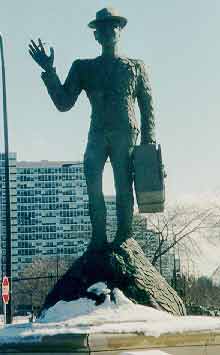
Statue of Migrant in Bronzeville
Bronzeville
|
Statue of Migrant in Bronzeville |
The gateway to Bronzeville, the neighborhood in Chicago dubbed the Black Metropolis during its heydey, is marked by a statue of a migrant, standing an a pile of shoe soles. This statue symbolizes the difficult trip which migrants made from the South to the North. It also marks a community which was founded, in a large part, by migrants. When migrants arrived in Chicago, many got off the train on the southern end of Bronzeville. From there, many were brought into the area by some of the neighborhood's larger churches, such as Olivet Baptist Church. Bronzeville is bounded by Twenty-sixth Street on the north, Lake Michigan on the east, Fifty-first Street on the south, and the Chicago, Rock Island, and Pacific Railroad tracks on the west. Bronzeville was a predominantly African American community on the South Side of Chicago which provided many diffenet services by African Americans for African Americans. Much like Mound Bayou in the Mississippi Delta, it was a space which was largely free from the regulation of whites, although it was a product of unequal economic, social and political access. |
Bronzeville was originally
inhabited by Irish Americans who worked at the nearby Illinois Central Railroad. The community's proximity to the
downtown business district also brought a lot of wealthy residents to the area who built large homes. After the
Chicago Fire of 1871, some German Jews also relocated to Bronzeville.
| African Americans began moving to Bronzeville during the 19th Century, finding jobs as domestic servants. With the increased demand for labor in Chicago, more and more African Americans moved to Chicago and found a home in Bronzeville. The race riots in 1919, caused many of the Irish and Jewish residents to move out of the neighborhood, creating a predominantly African American community. Migrants lived alongside musicians, business men, and rich African Americans who had been excluded from living in other neighborhoods. It was also the stopping point for many famous jazz and blues musicians. Bronzeville quickly became overcrowded and started to deteriorate. Despite the sometimes horrendous living conditions, Bronzeville functioned as a center of black culture and activity. A black metropolis developed in Bronzeville, where African American entrepreneurs came to the area to provide services to the African American community. Bronzeville drew many African Americans because it offered a variety of jobs for immigrants. Bronzeville offered a host of retail shops, dance halls, clubs, and churches. There were also a host of social services aimed at bettering the condition of the poor migrants. It was the home to the first African American-owned and operated bank and insurance company. It was also home to numerous large churches, such as Quinn Chapel, as well as to the Defender and the Chicago Bee, two of Chicago's predominant African American newspapers. |
Apartment in Bronzeville www.tourblackchicago.com |
|
|